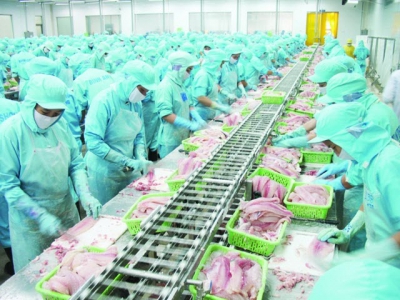Vietnam aims to be the world leader in seafood production and exports

The main target set for2030 is the value of seafood export turnover to reachUS$14-16 billion; by 2045, Vietnam will be a hubof deep seafood processing, belonging to the group of three leading seafood producing and exporting countries in the world.
According to the Ministry of Agriculture and Rural Development, after 10 years of implementing the Fisheries Development Strategy up to 2020, it shows that in the 2010-2019 period, the GDP structure of the fishery sector in the entire agricultural sector increased from 17.8% to 24.4%.
Fishery production increased from 5.1 million tons to 8.2 million tons. Seafood export turnover increased from US$5 billion to US$8.6 billion, equivalent to 1.7% of the total export turnover of the country and 20.8% of the agricultural export turnover.
Fisheries create jobs for about 3.9 million employees, contributing to the restructuring of the agricultural and rural economy; the income of fishery workers is constantly improving.
In addition to the above achievements, in the Statement on the Approval of Vietnam's Fisheries Development Strategy to 2030, with avision to 2045, that the Ministry of Agriculture and Rural Development just sent to the Prime Minister also stated that the fisheries sector reveals many shortcomings and inadequacies that are not commensurate with potentials and advantages.
Fishery development is not really sustainable, stable and effective; the competitiveness of our country's aquatic products in regional and international markets is not high, and the production scale remains small; the structure of the fisheries sector is not reasonable.
Along with that, the fisheries infrastructure system is outdated and asynchronous; investment capital for fisheries infrastructure remains difficult; there is ineffective production organization; while the quality and added value of the fisheries sector remains low.
The main cause is both subjective and objective, but the representative of the Ministry of Agriculture and Rural Development affirmed that the subjective cause is the main one.
This is reflected in the fact that the production relationship is still very fragmented, the lack of a large commodity production mindset between raw material producers and processing establishments, and between production and business establishments with management agencies and scientists, especially alack of the linkage of the domestic seafood value chain with the global seafood value chain.
This leads to high production costs and reduced international competition. On the other hand, management thinking is still bold applying machinery and operating mechanisms, not following the market mechanisms and not meeting the requirements of international integration (the EU yellow card is evidence of this).
The Ministry of Agriculture and Rural Development also mentioned that the budget allocated is not enough in quantity and time as required by the sector.
The fisheries sector is entering a new stage of development, on the basis of outstanding achievements of the previous period, along with challenges in the new context, according to Deputy Minister of Agriculture and Rural Development Phung Duc Tien: "Issuing the Vietnam Fisheries Development Strategy to 2030, with a vision to 2045, is very necessary.”
The main target set by 2030 is the growth rate of aquatic production value of 3.0 - 4.0% per year; the total production of aquatic products domestically produced 9.8 million tons (of which aquaculture output was 7 million tons, fisheries production was 2.8 million tons); and seafood export turnover value reaches US$14-16 billion.
Creating jobs for over 3.5 million employees, with per capita income of aquatic workers equivalent to the average income of workers nationwide.
With a vision to 2045, fisheries will be a modern, sustainable commercial sector, with advanced management, science and technology; a center of deep seafood processing, belonging to the group of three leading seafood producing and exporting countries in the world.
Keep an important position in the structure of agricultural economic sectors and marine economy, contributing to ensuring nutrition security, food, national defense and security, the sovereignty of sea and islands.
Compared to 2019, by 2020, the total output of aquatic products will reach 8.4 million tons, up 1.8%; seafood export turnover reached US$8.4 billion, down 0.8%. The total area of aquaculture in 2020 will reach about 1.3 million hectares (equal to 100% compared to the same period in 2019) and about 10 million cubic meters of cages (7.5 million cubic meters of saline cages and 2.5 million cubic meters of fresh farming). Farming output reached 4.56 million tons (up 1.5% over the same period in 2019), of which farmed shrimp production reached 950,000 tons, pangasius reached 1.56 million tons.
Có thể bạn quan tâm
 Why industry and academic collaborations are aquaculture’s secret weapon
Why industry and academic collaborations are aquaculture’s secret weapon Collaboration between researchers and industry players is essential for the sector’s continued growth
 Advancing the sustainability of farmed shrimp
Advancing the sustainability of farmed shrimp If impact financing is key to sustainable shrimp farming, how can satellites, mobile phones and big data accelerate this process?
 Time to rethink aquaculture sustainability indicators?
Time to rethink aquaculture sustainability indicators? A drive to produce a greater volume of species that are associated with low trophic levels in aquaculture systems “may be unhelpful” for making the sector more